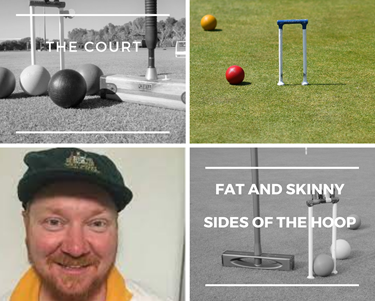Fat and skinny sides of the hoop

As mentioned I like to term the court as having a Fat and a Skinny side. Quite simply the skinny side is the side closest to a boundary. The fat side is furthest from a boundary. For example the western side of hoop 1 is the skinny side and the eastern side is the fat side. Generally it is better to be on the skinnier side as you can clear your opponent further. If your opponent goes to the skinny side first you have two ways of attacking – same/ same but different, or opposites.
Same/Same But Different (SSBD) Skinny Side– I’ll use hoop 1 for the examples but it can be used on all hoops if you think about it. If your opponent has overshot the hoop and gone long then SSBD means you also go long. The first ball to the hoop is usually trying to either position to score or position to clear. If your opponent has gone long then going longer yourself means they can only clear you to the short boundary. They cannot afford to position their second ball to the hoop directly in front as you will have a short clearance shot from the boundary. You can’t go too close to the opponent’s first ball as they will be able to block your clearance too easily. This is actually PPHH play that I mentioned earlier.
The position for the SSBD ball is basically anywhere that the first ball cannot cut or clear your ball away from defending the front of the hoop. You can also use the SSBD idea for distance. Instead of following a similar line but longer use the idea of SSBD to travel the same length as your opponent but a different line. Usually for hoop 1 this means staying closer to the south boundary. You can defend the scoring zone in front of the hoop and your opponent can only clear you to a short boundary. The extra distance away from your opponent makes their ability to block a lot harder as well.
SSBD – Fat Side – If your opponent is short to a hoop and you also go short, it is usually a suicide shot for most hoops. If your opponent is able to position their second ball to the hoop in a scoring position then your fat side SSBD ball is going to get belted to the far boundary and you then have a pressure long clearance. You would usually only intentionally position your ball short on the fat side if you know your opponent’s second ball cannot make position into the scoring zone. That is they are wired from a good spot, stuck in jaws or have a hampered shot from hoop or balls.
You are intentionally placing your ball in a clearance (tice if you prefer) position to draw your opponent further from the hoop. If they attack you and play the shot poorly you may have an easy approach back to the scoring zone. If they choose not to attack, you will usually have a short clearance shot yourself. Using the hoop 1 example I would do SSBD same line only to entice the opponent away from the hoop or into a bad shot. I would use SSBD same distance but different line to keep close to the south boundary which may provide me with a shot on the hoop or a potential in-off.
When your opponent is short to a hoop I would generally try to play opposites though.
Opposites – Skinny Side – If your opponent has gone long then opposites is just that go directly opposite them trying to use the hoop to wire. Even hoops this is obvious as you will often be in the scoring zone yourself. For odd hoops you are playing opposite to put pressure on your opponent. Their first ball did not make it. Your first ball is now wired from them. They cannot make good position with their second ball as they have no way of defending it anymore. Although you were second to the hoop you have control over the scoring zone.
Playing opposites does not always have to be in a wired position either. It is stronger as it allows you to control the scoring zone while not being able to score or get cleared yourself. If your opponents second ball is hampered/wired to the scoring zone you might choose to play opposites but leave yourself open to the opponents first ball. If your opponent has gone long to the skinny side and you play short to the fat side you are trying to provide a target/tice/bait for your opponent to shoot at you. They will do this if you are within a potential jaws or scoring zone. Playing opposite in this instance means your opponent cannot in-off and you are drawing them over to the fat side. If cleared you are then able to return to the skinny side, wired or otherwise. You have “danced” around your opponent and gained more power on the hoop as your opponent can now only clear you to the short boundary. The pressure is on them to win back a hoop that should have been fairly straightforwardly theirs.
Opposites – Fat Side – This is basically as the above paragraph explains. On odd hoops, if your opponent is short to the fat side you are given a great chance to play opposite and control the more powerful skinny side and the scoring zone. On even hoops playing opposites is a lot more dangerous as your opponent is still in a potential scoring zone. Intentionally playing opposite to the skinny side in this instance is because you believe they are about to jaws. You are basically telling your opponent you don’t think they can score the hoop.

